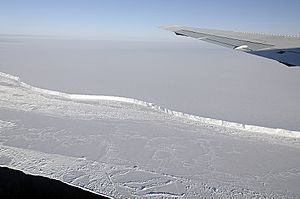Brunt Ice Shelf facts for kids
The Brunt Ice Shelf is a huge floating sheet of ice found off the coast of Antarctica. It's located along the edge of a place called Coats Land. This giant ice shelf sits between two large ice streams: the Dawson-Lambton Glacier and the Stancomb-Wills Glacier Tongue.
Contents
What is an Ice Shelf?
An ice shelf is a thick, floating platform of ice. It forms where a glacier or ice sheet flows down to a coastline and onto the ocean surface. Ice shelves are attached to the land, but they float on the water. They act like a barrier, slowing down the flow of ice from the land into the sea.
How the Brunt Ice Shelf Got Its Name
The Brunt Ice Shelf was named by a group called the UK Antarctic Place-names Committee. They named it after a British scientist named David Brunt. He was a meteorologist, which means he studied weather and the atmosphere.
David Brunt was important because he helped start a big science trip. This trip, called the Royal Society Expedition, went to the ice shelf in 1955.
Research and Exploration
The Brunt Ice Shelf has been a key spot for scientific research.
The Royal Society Expedition
From 1955 to 1959, the Royal Society Expedition used the Brunt Ice Shelf as their base. Scientists studied the ice, weather, and the environment.
Halley Research Station
After the expedition, the base was taken over by the United Kingdom. It became known as the Halley Research Station. This station is still used today for important scientific studies in Antarctica.
The Brunt Icefalls
The Brunt Icefalls are steep, icy cliffs located near the Brunt Ice Shelf. They stretch for about 80 kilometres (50 mi) along the Caird Coast. This is where the ice-covered land drops sharply down to meet the Brunt Ice Shelf.
Discovery of the Icefalls
The Brunt Icefalls were first seen on November 5, 1967. This happened during a flight by a United States Navy squadron called VXE-6. They were flying an LC-130 aircraft over the coast. Later, the United States Geological Survey mapped the icefalls using air photos from that flight. The icefalls were named by the Advisory Committee on Antarctic Names because they are so close to the Brunt Ice Shelf.
Big Iceberg Breaks Off!
Ice shelves can sometimes have large cracks. These cracks can grow and cause huge pieces of ice to break off. This process is called "calving."
Cracks in the Ice
In 2012, scientists noticed that some very large cracks in the Brunt Ice Shelf were getting bigger. These cracks went all the way through the ice to the sea below. Experts thought that big parts of the ice shelf would break off soon.
Iceberg A-74 Calves
On February 26, 2021, a massive iceberg finally broke away. This new iceberg was named Iceberg A-74. It was about 1,270 km2 (490 sq mi) in size. That's like a really big city!
The iceberg separated from the northern edge of the ice shelf. It broke off near a place called the McDonald Ice Rumples. It then joined up with another large crack called the Brunt-Stancomb chasm.
As of February 28, 2021, Iceberg A-74 was located at 75° 13' South, 25° 41' West. It measured 30 nautical miles (56 km) at its longest point and 18 nautical miles (33 km) at its widest point.


